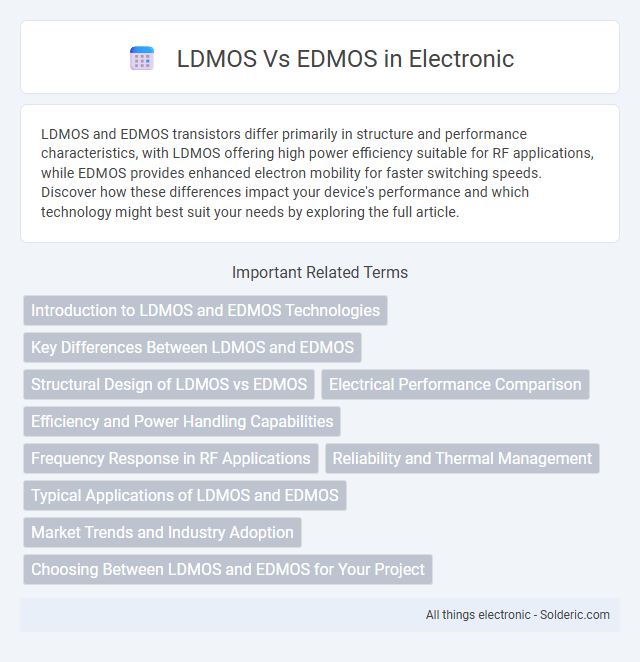LDMOS and EDMOS transistors differ primarily in structure and performance characteristics, with LDMOS offering high power efficiency suitable for RF applications, while EDMOS provides enhanced electron mobility for faster switching speeds. Discover how these differences impact your device's performance and which technology might best suit your needs by exploring the full article.
Comparison Table
| Feature | LDMOS (Laterally Diffused MOSFET) | EDMOS (Extended Drain MOSFET) |
|---|---|---|
| Structure | Laterally diffused channel with extended drift region | Enhanced extended drain for better current handling |
| Applications | RF power amplification, base stations, communication amplifiers | High-voltage power devices, industrial power management |
| Voltage Rating | Typically 20V to 100V | Can exceed 100V with improved handling |
| Switching Speed | Moderate switching speed | Improved switching speed due to reduced charge storage |
| On-Resistance (Rds(on)) | Low to moderate, optimized for RF applications | Lower Rds(on) for higher current efficiency |
| Thermal Performance | Good thermal stability | Enhanced thermal dissipation for high power |
| Manufacturing Complexity | Relatively standard LDMOS process | More complex due to extended drain design |
Introduction to LDMOS and EDMOS Technologies
LDMOS (Lateral Diffused Metal-Oxide-Semiconductor) and EDMOS (Extended Drain Metal-Oxide-Semiconductor) are advanced power transistor technologies used primarily in RF and high-voltage applications. LDMOS offers high efficiency and robustness in wireless communication systems, while EDMOS is designed for enhanced breakdown voltage and improved ruggedness in power switching devices. Understanding the differences between LDMOS and EDMOS helps you select the optimal transistor for your specific high-frequency or high-power requirements.
Key Differences Between LDMOS and EDMOS
LDMOS (Laterally Diffused Metal-Oxide-Semiconductor) and EDMOS (Extended Drain Metal-Oxide-Semiconductor) differ primarily in their structural design and performance characteristics, with LDMOS featuring a laterally diffused channel ideal for high-power RF applications, while EDMOS incorporates an extended drain region that enhances breakdown voltage and reduces on-resistance. LDMOS devices typically offer better efficiency and frequency response, making them suitable for cellular base stations, whereas EDMOS provides superior ruggedness and voltage handling, often used in power management circuits. Your choice between LDMOS and EDMOS depends on the specific requirements for power handling, frequency, and thermal performance in your application.
Structural Design of LDMOS vs EDMOS
LDMOS (Lateral Double-diffused MOS) features a lateral structure with a double-diffused channel, enabling high breakdown voltage and improved ruggedness in RF power devices. EDMOS (Extended Drain MOS) incorporates an extended drain region, which enhances voltage handling capability by distributing the electric field more evenly across the device. The structural design differences between LDMOS and EDMOS significantly influence their performance in high-frequency and high-voltage applications.
Electrical Performance Comparison
LDMOS transistors typically offer higher power efficiency and better thermal stability compared to EDMOS devices, making them ideal for high-frequency and high-power RF applications. EDMOS devices exhibit lower on-resistance and faster switching speeds, which improve performance in low-voltage, high-speed circuits. Your choice between LDMOS and EDMOS should consider the specific electrical parameters such as breakdown voltage, switching losses, and thermal management requirements.
Efficiency and Power Handling Capabilities
LDMOS transistors offer superior efficiency and power handling capabilities compared to EDMOS devices, making them ideal for high-frequency RF power amplifiers in base stations and broadcasting applications. Their lateral diffusion structure enables lower on-resistance and better thermal performance, resulting in higher power density and improved linearity. You can rely on LDMOS for enhanced reliability under demanding power conditions, whereas EDMOS generally suits lower power, less thermally intensive scenarios.
Frequency Response in RF Applications
LDMOS transistors excel in frequency response for RF applications due to their high electron mobility and lower parasitic capacitance, making them suitable for high-power amplifiers up to several GHz. EDMOS devices offer lower on-resistance but generally have slower switching speeds and higher parasitic capacitances, limiting their effective frequency range. Your choice should prioritize LDMOS for superior linearity and efficiency in demanding RF frequency performance.
Reliability and Thermal Management
LDMOS transistors offer superior reliability and enhanced thermal management compared to EDMOS due to their robust drift region design, which allows efficient heat dissipation under high power conditions. EDMOS devices, while compact, often face challenges with thermal resistance, leading to increased risk of thermal runaway and reduced lifespan. Choosing LDMOS can improve your system's durability and maintain stable performance in demanding thermal environments.
Typical Applications of LDMOS and EDMOS
LDMOS transistors are extensively used in RF power amplifiers for cellular base stations, broadcasting, and radar systems due to their high efficiency and robustness at high frequencies. EDMOS technology finds typical applications in power management and low-voltage analog circuits, benefiting from its low on-resistance and fast switching capabilities. Your choice between LDMOS and EDMOS depends on the specific requirements for power handling and switching speed in the intended application.
Market Trends and Industry Adoption
LDMOS (Laterally Diffused Metal-Oxide-Semiconductor) transistors dominate the RF power amplifier market due to superior power efficiency and reliability, especially in 4G and emerging 5G infrastructure. EDMOS (Enhancement-mode MOS) devices are gaining traction in low-voltage, high-frequency applications but lag behind LDMOS in power handling and thermal management. Market analysts predict steady LDMOS growth driven by telecom infrastructure investments, while EDMOS adoption is niche, focusing on specialized RF modules and integrated circuits.
Choosing Between LDMOS and EDMOS for Your Project
Choosing between LDMOS (Laterally Diffused Metal-Oxide Semiconductor) and EDMOS (Extended Drain Metal-Oxide Semiconductor) depends on specific project requirements such as power handling, frequency operation, and efficiency. LDMOS devices excel in high-power, RF amplification applications due to their robust high-voltage capabilities and linearity, making them ideal for base stations and broadcast transmitters. EDMOS offers advantages in lower-voltage, lower-frequency circuits where reduced on-resistance and improved switching speeds are critical for energy-efficient designs and integrated power management.
LDMOS vs EDMOS Infographic

 solderic.com
solderic.com